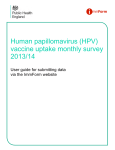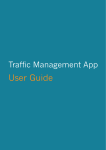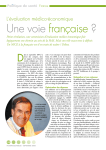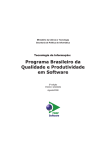Download Check it out for love or money: user guide
Transcript
Check it out for love or money: user guide About The NSMC We are The NSMC, the international centre of behaviour change expertise. We’re dedicated to making change happen that improves people’s lives. We do this by supporting organisations to design cost-effective programmes that help people adopt and sustain positive behaviours – those that improve their lives. Eating healthily, being more active and saving energy are just some of the positive changes we have helped our clients achieve. As well as programme support and strategic advice, we also provide professionals with the skills and resources to design and deliver their own cost-effective behaviour change programmes. Originally set up by the UK Government, we now have a global reach, applying social marketing skills, knowledge and experience from around the world to solve behavioural challenges. www.thensmc.com 1 Contents 1 Introduction 3 Using the tool 8 Interpreting the results 12 Other pages of the tool 13 Acknowledgements 14 References THE NSMC CHECK IT OUT FOR LOVE OR MONEY i Introduction The NSMC has worked with leading health economists and NICE to develop a suite of online Value for Money tools. These will help practitioners and commissioners to calculate the value for money of their social marketing and behaviour change programmes. The Bowel Cancer Screening tool is one of those developed. 1 THE NSMC CHECK IT OUT FOR LOVE OR MONEY The tools have two important uses: 1. To help plan for social marketing and behaviour change programmes by estimating the likelihood that they will provide value for money. 2. To evaluate whether social marketing and behaviour change interventions were value for money on completion. The tools go beyond costs to the NHS to include wider societal costs. Using the tool These guidelines are intended to both help users and to provide a background on the development of the tool. You may also wish to refer to the glossary and NICE Intervention Costing Guidelines available on The NSMC’s website. Most users may choose to only use the Data Input and Results pages but advanced users can also make use of other pages to update the tool as further evidence becomes available. The tool will help you to evaluate the Value for Money (VfM) of social marketing and other initiatives to improve the response rate to bowel cancer screening – specifically to return the Faecal Occult Blood test samples (FOBt). This is intended to support other guidance and advice in this area, rather than to replace it. At this stage, economic analysis of local interventions to support FOBt is at an early stage of development, though the national programme itself has been reviewed. The tool is based on initial estimates of expected response to FOBt, a biennial screening programme for everyone between the age of 60 and 69 and its long-term VfM. This is based on current costs and expected long term outcomes. These data will need to be improved and updated from time to time as we learn more about these impacts. The tool shows a range of values reflecting uncertainty in estimates of achieving behaviour change. It does not reflect the underlying uncertainty of health gain or NHS cost estimates. This will provide a sensitivity analysis around the central case. Note that in all cases it is more appropriate to report a range of possible values than to give an over-precise single estimate. Data input Completing the data input sheet The following section provides details of what data should be included in each section of the tool, and also what evidence has been used in its development. Intervention costs The tool can be used to evaluate costs and outcomes over five or more years, one year or over a shorter period. For longer-term projects it will allocate one-off planning and start up costs over the lifetime of the intervention. Detailed advice on what costs should be included is provided in the NICE costing guidelines which are available on The NSMC website (www.thensmc.com/resources/vfm/guidelines). Further information about what should be included in each field is detailed below. 1. In Table 1 please enter the: a) Cost of planning and developing the intervention The tool can be used to evaluate costs and outcomes over one year. For longer term projects the tool will allocate one-off planning and start up costs over the lifetime of the intervention to provide an equivalent one year cost. These costs are assumed to be at the base year price level and that this is the same as the year for which outcome results are reported. If this is not the case and the development and training costs relate to an earlier year then they should be inflated to the same price level. All other outcomes and savings will be automatically discounted this base year level. Intervention costs relate only to local social marketing or other programmes that support FOBt response and not the operation of the FOBt screening itself. However the tool does take into account the cost consequences for the screening and treatment services, derived from expert studies in this field. THE NSMC CHECK IT OUT FOR LOVE OR MONEY 2 The separation between intervention costs and NHS costs assumes that behaviour change support may be funded by a PCT, Clinical Commissioning Group or Local Authority. This is separate from the provision of services such as the operation of the FOBt screening and follow-up diagnosis and treatment. Furthermore, aspects of the intervention might be funded by employers or other community sponsors such as cancer charities. However, throughout this analysis all costs are mutually exclusive so please avoid any double-counting except for incentives which are both a cost to the intervention and a negative cost (payment or gift) to clients. Development and capital costs will be spread over the life of the intervention. These should include costs relating to the design and application of a specific behaviour change project for target clients. General needs assessment, such as a JNSA, should be excluded. However research conducted during the scoping phase for the specific project should be included. b) Annual revenue costs per year of supporting the intervention These should include: direct management and staff time; consumables such as leaflets; incentives; and rent of facilities and equipment. Where the project, or elements of it, are contracted to private or voluntary sector providers, VAT should be excluded (because this is a transfer to government), but all other costs relating to one year of full operation and management of the contract should be included. Full public sector staff costs and on costs should be included but not unavoidable central overheads (e.g. management and premises costs) that are not changed by the project. 2. In the field entitled ‘What are the…’ (Table 1), the following costs should be considered and included when relevant: a) NHS set up costs including capital, training, and reorganisation Capital or other one-off set up costs such as retraining and reorganising staff and services should be included. Set up costs may include training with GPs and Practice Nurses and other staff advising or conducting the development of the project. These will be spread over the life of the project. b) NHS annual revenue costs per year The costs of additional investigations and treatments generated by increased responses to the FOBt are automatically generated by this tool and do not need to be estimated. However, there may be additional costs such as offering services at times and locations more suited to clients or providing translation facilities. 3. Over how many years should development and training costs be spread? Capital costs and project development costs will be spread over the life of the intervention. You should select the number of years that the intervention will benefit from the set up costs. These costs are assumed to be at the base year price level and that this is the same year as the year for which outcome results are reported. If this is not the case (e.g. development and training costs relate to an earlier year), then they should be inflated to the same price level. All other outcomes and savings will be automatically discounted this base year level which should be selected at question 2.8. 4. Add in any other public sector costs, if relevant: a) Project development and capital expenditure If the intervention requires input by other public sector providers such as social workers or community support workers, set up costs for their training may 3 THE NSMC CHECK IT OUT FOR LOVE OR MONEY be relevant. However, it is important to consider only additional costs above those already incurred by services in the normal course of their work and training. b) Annual revenue costs per year Annual costs to other public sector services should be included here if relevant. 5. Charges, costs or incentive payments to clients (if relevant) If clients pay for items or services then the aggregate annual cost should be recorded as a social cost rather than a project cost. Payments to clients as incentives or subsidies should be included as both an element of project cost and as a payment to clients. The aggregate level of all incentives for a year should be entered as a negative number (i.e. a payment). 6. Employer, NGO and other partner costs (if relevant) a) Project development and capital expenditure If employers (or other partners such as NGOs, supermarkets or food producers) contribute to the cost of an intervention, this should be recorded as a social cost. This should reduce the public sector intervention costs. In this box enter any capital or start up costs to them. b) Annual revenue costs per year Annual costs to employers, NGOs or others should be entered here. Clients and Outcomes: Response to FOBt Biennial Survey for 60-69 year olds Enter information on the number and characteristics of clients and outcomes planned or achieved. The tool can be used to assess planned interventions or to evaluate current projects. “It is important to consider only additional costs above those already incurred by services in the normal course of their work and training” THE NSMC CHECK IT OUT FOR LOVE OR MONEY 4 1) Number of clients sent FOBt Kits and targeted by the behaviour change intervention If the intervention is targeted at all local residents receiving FOBt, this should be the number of people receiving FOBt kits per year. If the intervention is targeted at a particular group of people (e.g. obese people or people from an ethnic community), the number of people targeted who would also receive FOBt kits in a year should be entered here. 2) Percentage planned or actual response to FOBt This is the percentage of people from your target group (i.e. those receiving FOBt kits and addressed by the social marketing or other behaviour change intervention) who actually send samples as requested. As noted you may use the tool to evaluate a planned intervention, in which case you should enter your expected response rate. To evaluate an ongoing programme, enter the response rate achieved by the target group as a result of the intervention. For a sensible result it must be greater than the expected level. 3) Behaviour Indicator This is to allow you to enter the name of the specific target indicator, for example: ‘Response rate among people of Pakistani origin living in Bradford’. 4) Expected level of response to FOBt screening without intervention The expected level of response is automatically generated by the tool based on the average level indicated by Weller et al (2006)1. The response rate for the overall pilot programme was 52 per cent but the response rate to be expected locally varies with the Index of Multiple Deprivation (IMD) of the area of residence of respondents as follows: • • Quintiles 1-4 = 56% Most deprived quintile = 40% The estimate also reflects variations relating to ethnicity and religious communities are taken from 5 THE NSMC CHECK IT OUT FOR LOVE OR MONEY the UK CRC Screening Pilot Evaluation Team (2003)2. This shows that response rate variations relate largely to the percentage of people from Muslim communities for whom a response rate of 32 per cent was found. Other ethnic groups showed response rates predicted for their area of residence IMD. While there are differences between male and female response rates, these were less than differences according to IMD or religion. To model the relationship between the variables noted above and FOBt response would require an analysis of the combined effect of the two variables (the coefficient of multiple determination). However, this is not available, although it is possible to approximate to this. The formula used to generate the expected response rate to FOBt is: Expected FOBt response rate =56 per cent of the population targeted less those in most deprived quintile and Muslims plus 40 per cent of targeted population in most deprived areas and 32 per cent of the number of people from Muslim Communities. No doubt this aspect of the tool could be improved as further data becomes available. It should also be possible to estimate the expected response rate, taking into account a range of other factors that affect behaviour such as male/female response rates. 5) What percentage of clients targeted are in the most disadvantaged 20% of IMD areas (excluding Muslim communities)? This provides a measure of the extent to which the intervention is targeted at disadvantaged groups. If there is no bias towards disadvantage, 20 per cent of respondents would be expected to be in this category (excluding Muslims from this figure this would be 18 per cent). Disadvantage may be measured by the Index of Multiple Deprivation (IMD) scores (see Glossary) or other ways determined locally. 6) Percentage of clients in the most disadvantaged 20% and from Muslim Communities These figures are used to estimate the expected response rate. For technical reasons it is necessary to estimate the percentage of Muslim clients who are disadvantaged separately. 7) The actual percentage response to FOBt (if available) If you conduct a ‘before and after’ survey or have details of FOBt response rates from the years before and after the intervention, simply enter the data here. These figures will replace the estimates of expected and actual respondents generated above. If you have not conducted such surveys, the tool will use estimates based on the percentage of respondents from most deprived wards shown by IMD and the estimated percentage of people from Muslim communities. Enter zero (0) in this box. 8) What year’s prices are you using? This is to allow you to enter the name of the specific target indicator, for example, ‘Response rate amongst people of Pakistani origin living in Bradford’. 9) Enter your weight for disadvantage (optional) This allows you to give an extra value to impacts on disadvantaged and hard-to-reach groups. A value between 0 and 100 per cent can be used (but enter ‘0’ if you do not wish to apply a weight) giving that percentage more value to interventions for disadvantaged people. The tool does this by simply adding an extra value to the percentage of clients in the most disadvantaged 20 per cent using either IMD scores or in some other way that you may define. This means that, if you chose a weight of 50 per cent and all the clients were in the most disadvantaged group, a value of the outcomes will be shown as 50 per cent more than the outcomes for a project which did not address disadvantaged people. THE NSMC CHECK IT OUT FOR LOVE OR MONEY 6 While this value is shown in the Results page, the Social Return on Investment estimates are not weighted. Giving an extra weight or ‘utility value’ to disadvantage is controversial. The Department of Health’s policy is not to weight QALYs because everyone’s health is equally valuable. On the other hand, it can be said that addressing disadvantage is an important priority and therefore gives extra value. 10) Enter the Reach of the intervention (optional) The ‘Reach’ of the project is a term used in the Health England Leading Prioritisation (HELP) scheme. If you want to apply their measure of the value placed on addressing equity and the priority of this project, you may wish to include a value here to represent the proportion of people who could be eligible for the intervention if it were extended nationwide. Note that this may not include all of the people included in the FOBt programme but only the sub-group of people who receive FOBt kits and are targeted by your intervention. This does not need to be very precise as the HELP utility measure is not very sensitive at this level. 11) Disadvantage Weight Generated by HELP The results will also show the effect of weighting for disadvantage and a priority score from the HELP programme. This project surveyed the way 99 public health professionals prioritised projects. It then developed a formula to model their values (Utility) as a preference curve based on cost effectiveness (Cost per QALY, C), the reach of the project (what proportion of the population could benefit, R) and impact on disadvantage (percent of clients in most disadvantaged 20 per cent, D). This tool derives a weight for disadvantage by substituting values from the current project in this formula. It is also replicates the utility score that would be given by the HELP formula. 7 THE NSMC CHECK IT OUT FOR LOVE OR MONEY Utility = e(-0.0000586x C + 0.0435987 x R + 0.119895x D) For a detailed explanation of this see: http://help. matrixknowledge.com You may choose to ignore these methods of weighting outcomes and treat disadvantage as a separate issue. The Department of Health suggest using the Health Inequalities Intervention toolkit available from the London Health Observatory at: www.lho.org.uk/LHO_Topics/Analytic_Tools/HealthInequalitiesInterventionToolkit.aspx Interpreting the results The results page reports a wide range of outcome measures that were requested by various local and national users during the piloting of these tools. You may decide that some of these are not relevant to your needs; it is up to you to choose which measures are most useful for your purposes. You need to take into account the decision-makers priorities and the strength of the available evidence which varies for different outcome measures. Sensitivity analysis In general, it is more reasonable to report a range of possible outcomes rather than just reporting a single central estimate. The sensitivity analysis shows a high and low value range arising from different assumptions about the behaviour change that would be expected. These correspond to estimates of the expected response rate which are up to ten per cent higher or lower than the central estimate. The higher range is limited to ensure that the increase does not exceed the actual rate as this would produce an invalid outcome. The sensitivity analysis in this tool does not consider the uncertainty in underlying estimates of health gain and costs, which are treated as consensus estimates. In the source used for most of the estimates of health and cost impacts3, a range of 350 per cent is indicated for the impact estimates. However, if this range were applied it would negate the purpose of the tool which is to provide consensus-based values which can be applied by local teams. Table 1: Net Local Public Sector Cost per Lifetime Health Gain This table provides a range of outcome and VfM measures requested by users. Health impact The estimated impact of returning the FOBt sample in QALYs is taken from Tappenden et al (2006). The figure shown represents the current value of the lifetime reduction in health risks arising from the intervention. This is done by comparing the value of the response targeted or actually achieved with the expected outcome without the intervention. Marginal health outcome improvements quoted in Tappenden et al (2006), show a health gain of 0.0104 QALY per contact for biennial screening from age 60 to 69. To generate health gains per respondent (rather than per contact), these gains are increased by dividing by 60 per cent (the response rate assumed in the study). This estimate can be updated as new evidence emerges. The tool estimates health impacts in terms of lifetime health risks. It is not possible to provide a precise timescale for all resulting impacts on health or costs but, because these factors are discounted to the base year, the equivalent health impact and cost burden can be calculated. Most of the health gains relate to relatively short term gains (over ten years) for people in their 60s who may be expected to improve their chances of early detection and hence longer survival or even recovery from early stage bowel cancer. Since these risks are addressed by a one-off event (i.e. responding to the FOBt screening programme), there is no need to project long-term behaviour or discount the benefits as they are already taken into account. It is assumed that prompting response to one such round of screening will also encourage response to other rounds of FOBt. Thus response to FOBt assumes continuing response to further biennial checks. See the Glossary for a definition of QALYs. THE NSMC CHECK IT OUT FOR LOVE OR MONEY 8 “The tool permits you to add an extra value to the percentage of clients in the most disadvantaged 20 per cent” Public sector cost This is the summary of public sector costs per year for the intervention shown in the Data page and resulting from the costs you reported. VfM cost per QALY The VfM can be estimated as the total costs including additional costs generated for the NHS per health risk gain as a £ per QALY given as a high and low estimate as well as a central value. Additional costs to the NHS This is taken from Tappenden et al (2006). It is assumed that the costs quoted in this paper relate to 2002/2003 (as implied by the reference to NHS Reference Costs 2003). The paper quotes a marginal cost per client participating in FOBt screening of £24.53 including the cost of FOBt at £11.74. These are assumed to be net costs taking into account the lifetime savings arising from better detection and treatment of bowel cancer. These costs have been updated in line with the overall increase in NHS net expenditure. In turn, this estimate has been increased in line with House of Commons Library Standard Note SN/SG/7244. This gives a value in 2007/2008 terms which is adjusted to the base year chosen for analysis. This figure, plus the cost of the intervention, is divided by the QALY gain to provide an estimate of VfM in terms of cost per QALY. A range of values is provided, reflecting uncertainty in the main behavioural outcomes but not the underlying health or cost impacts. Total Public Sector Cost and VfM This is the cost of the intervention to the public sector plus the additional cost to the NHS. This is then divided by the QALY impact under high, central and low assumptions of behaviour impact to produce a range of VfM estimates. 9 THE NSMC CHECK IT OUT FOR LOVE OR MONEY Years of Life Gained and VfM in terms of £/YLG This is also derived from Tappenden et al. (2006). Marginal health outcome improvements quoted in Tappenden show a health gain of 0.0126 Life Year saved per contact for biennial screening from age 60 to 69. QALY per added FOBt Respondent To generate health gains per respondent (rather than per person contacted). These gains are updated and increased by dividing by 60 per cent (the response rate assumed in the study). Years of Life Gained per added FOBt response This is also derived from Tappenden (2006). Odds Ratio 1 to this Number This is a commonly used measure of the effectiveness of an intervention. In this case it is the ratio of the number of people responding to the FOBt screen as a result of the intervention to the number who would have done so without the intervention. Number Needed to Treat FOBt contact per YLG This is a measure used in primary care to assess the effectiveness of interventions such as treatment with Statins. In this case it has been applied to provide two measures of the number of people who would need to be offered FOBt screening without other intervention in order to gain one life year. Number Needed to Treat Behaviour Change and FOBt contact per YLG This is the number of people who would need to be contacted with the intervention in order to gain one life year. Table 2: Societal Impacts: Human Values, Social Return on Investment and Utility Score Value of a QALY assumed This can be regarded as the cost of pain and grief caused by death and illness. In discussion with Robert Anderson, Economic Adviser to Department of Health in 2011, it has been pointed out that the Department of Health’s official position is that a QALY can be valued at £60,000. This is derived from the Department of Transport’s willingness to pay survey of 1991/1992 (Highways Economics Note 1) in respect of fatal accidents updated to 2007 values. However, as NHS expenditure is limited, it is accepted that the marginal productivity of the NHS is four QALYs per £100,000. For this reason, a value of £25,000 can be applied. While the Department of Health continue to refer to a survey carried out in 1991/1992 for the Department of Transport, it should be noted that this willingness to pay survey focused on traffic accident outcomes. These include early death, which has a particular emotional value. Another estimate of the value of a QALY gain can be based on the upper estimate of the value placed on non fatal injury derived from the same survey which gives an estimate of £27,000. This is close to the figure used by NICE of £30,000. Thus, for this purpose a value of £25,000 in 2007/2008 has been used updated for inflation in incomes but this can be varied if required. Total value of QALYs saved weighted for disadvantage, Your Weights The tool permits you to add an extra value to the percentage of clients in the most disadvantaged 20 per cent using IMD scores, or in some other way you may define. This is simply the result of applying the weight or extra value you selected, to the percentage of targeted clients who are disadvantaged. Total value of QALYs saved weighted by Health England Leading Prioritisation scheme This uses the HELP utility scoring system to derive the weight ascribed to disadvantage by this scheme, by substituting values in the formula for the intervention with and without a bias towards disadvantage. HELP Utility Score This applies the HELP formula for assessing the utility or priority of the intervention. To put this in context, you should consult the web site introduced in the Data Input section of this guide. THE NSMC CHECK IT OUT FOR LOVE OR MONEY 10 Table 3: Societal Impact: Social Return on Investment The calculation of Social Return on Investment (SROI) does not take into consideration any weighting applied to QALYs as above. The SROI is expressed as a number; 1 would mean a return of a social value of £1 for every £1 spent by all stakeholders. A negative value indicates that the investment gives rise to additional social costs rather than financial savings. In this case, the investment is likely to generate reasonable returns if the values of QALY gains are considered. But since it increases NHS costs rather than avoid them, it will generate negative financial impacts. Since the tool addresses health issues for people, most of who are beyond working age, it is unlikely to generate benefits to employers or employees in terms of earnings. However, it may extend pension payments and hence returns to participants. SROI based on net impact on stakeholders This is calculated here as the net impact on all stakeholders divided by the total cost to stakeholders. SROI based on Value of QALYs gained Calculated as the value of the QALYs increased by the intervention valued at £25,000 in 2007/2008 terms. For more details of the SROI approach see the Glossary and related links from The NSMC website. 11 THE NSMC CHECK IT OUT FOR LOVE OR MONEY Other pages of the tool The other pages of the tool can be explored by users but these are basically working sheets. All references have been referred to in the Data input and Results sections of this guide. Research teams are invited to develop improved versions of such tools as more evidence becomes available. Impacts The Impacts page of the tool provides a mechanism for comparing the expected rate of response to FOBt with the rate targeted or achieved as a result of the intervention. This uses the formulae explained at point 4 of the Data Input guide. • The Impacts page also provides high and low scenarios, varying the expected rate of response by up to ten per cent higher or lower to provide a range of results reflecting the uncertainty in these estimates. Clearly, these data can be improved but it is suggested that this is a task for advanced users. General users do not need to change this. Tables This page provides details of the inflation factors used in the tool. It can be updated but again it is suggested that this should only be attempted by advanced users. Current guidance includes: • • • NICE 2004 Improving Outcomes in Colorectal Cancer available at www.nice.org.uk/csgcc Cancer Research UK 2011 Bowel Cancer: colorectal cancer available at www.cancerhelp.org.uk/type/bowel-cancer The University of Sheffield ScHARR Health Economics and Decision Science 2007 Colorectal Cancer: Bowel Cancer Services Costs and Benefits available at www.shef.ac.uk/scharr/sections/heds/ modelling/colorectal-cancers Department of Health 1997 Improving Outcomes in Colorectal Cancer: the Manual still helpful but updated by the NICE guidance as above, available at www.dh.gov.uk/prod_consum_dh/groups/dh_ digitalassets/@dh/@en/documents/digitalasset/ dh_4080283.pdf Inflation estimates for NHS costs are taken from official projections set out in House of Commons Library Standard Note SN/SG/7245. Other sources of help and guidance It is important to stress that this tool is intended to support evaluation alongside the application of qualitative guidance. It is not intended to replace or supplant any such guides. Its purpose is to try to translate the consensus on the costs and benefits of FOBt screening developed by expert research teams into useable mechanisms. These can be used to help local social marketing teams evaluate behaviour support programmes that encourage higher response rates. THE NSMC CHECK IT OUT FOR LOVE OR MONEY 12 Acknowledgements This guide was written by Dr Graham Lister, an Associate of The NSMC. The NSMC and Dr Lister would also like to thank the Project Advisory Board, the NICE team who provided cost data, the Cancer Research UK team and teams from Sheffield and York University from who provided some help, the Rechord team who worked on the presentation of the tool, the team from Matrix consulting who provided quality assurance and the many local social marketing groups and experts who tried it out and suggested improvements. Any remaining errors and omissions remain the responsibility of the author. 13 THE NSMC CHECK IT OUT FOR LOVE OR MONEY References 1. David Weller et al (2006), English Pilot of Bowel Cancer Screening: an evaluation of the second round 2. UK CRC Screening Pilot Evaluation Team (2003). Ethnicity: UK colorectal cancer screening pilot – final report 3 Tappenden et al (2006) Option appraisal of population-based colorectal cancer screening in England 4. Rachael Harker, House of Commons Library Standard Note SN/SG/724 NHS Funding and Expenditure 12 January 2011 5. Harker, 2011. THE NSMC CHECK IT OUT FOR LOVE OR MONEY 14 Further support from The NSMC Practical advice and support If you need some fresh thinking to improve your results, we’ll carry out an expert review of your current approach to behaviour change. Practical recommendations on how to plan, manage, implement and evaluate your projects will ensure you’re able to make progress. Need help taking a behaviour change approach forward? We can develop a behaviour change strategy for your organisation – ensuring you’re better placed to deliver effective future programmes. We’ll support you through developing and managing your project, with mentoring offered as and when you need it. Using our ‘learning by doing’ approach, we bring our tried and tested behaviour change planning process to your behavioural challenge. To help make your project happen, we can also bring your stakeholders together and secure their involvement in achieving your objectives. Our tailored, interactive workshops, delivered by The NSMC’s expert behaviour change professionals, will explore how to take an audience-led approach to your challenge − using the latest thinking in behaviour change from your sector. Implementing an effective behaviour change project Whatever your behavioural www.thensmc.com challenge, our experts’ unrivalled experience in delivering behaviour change programmes will ensure it is addressed costeffectively. Our network of consultants and suppliers means the best specialists will take your project forward. Training and resources To give you and your team the skills you need to run your own behaviour change projects, we provide both classroom and e-learning training courses. Devised and delivered by expert professionals, they draw on real experience of what works. To help ensure your staff have the right tools and support when they need them, our online planning guide and toolbox provides everything they need to plan and implement a behaviour change programme. Tried and tested by a range of professionals and organisations, we can develop specialised versions, tailored to meet your organisational needs. Supporting your organisation to keep your audiences at the heart of everything you do We’ll help you develop and conduct research that will give you a firm foundation for a behaviour change intervention. Our experts will help ensure you get the most from your research budget. Our One Stop Shop database of unpublished market research gives you the means to quickly get to grips with your audience and behavioural challenge. It will enable you to focus your research and make the best use of your resources. If you’re pushed for time, our data synthesis service will package up the most relevant research into your challenge held on the One Stop Shop for you. Providing best practice in behaviour change ShowCase is our online case study database of behaviour change initiatives. From smoking to active travel, young people to health professionals, it highlights honest learning and success from the real world on a wide range of issues and audiences. You can follow the journey project teams took and find detailed information on the ‘how’ of delivering a behaviour change intervention. Capitalise on others’ achievements and learn from their mistakes and barriers, without having to commission expensive research. Independent evaluation We have specialist experience of evaluating behaviour change programmes of all kinds. We’ll help you demonstrate the impact of your projects to your stakeholders and capture lessons to improve future work We’ll also help you put together an evaluation plan that will ensure you collect the right information to effectively measure success and avoid knowledge gaps from the outset 2 Contact The NSMC Fleetbank House Salisbury Square London EC4Y 8JX T. 020 7799 7900 F. 020 7799 7901 www.thensmc.com Designed by Toby Hopwood





























